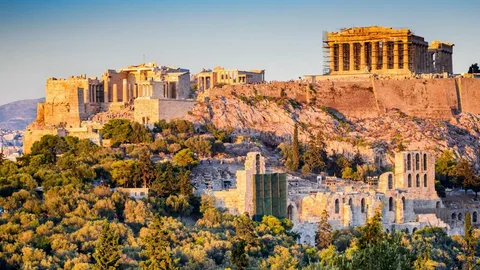Athens, Greece, is a city steeped in history, with roots that stretch back over 3,000 years. Known as the cradle of Western civilization and the birthplace of democracy, Athens is home to a wealth of historical landmarks that offer a glimpse into the city’s glorious past. From ancient temples and theaters to historic neighborhoods and museums, Athens is a treasure trove of cultural and architectural wonders. This article will explore some of the most significant historical landmarks in Athens that every visitor should include on their itinerary.
- The Acropolis of Athens
The Acropolis of Athens is undoubtedly the most iconic landmark in Greece. Perched on a rocky hill overlooking the city, the Acropolis is a symbol of ancient Greek civilization. The centerpiece of this site is the Parthenon, a temple dedicated to the goddess Athena, the city’s patron deity. Built in the 5th century BC, the Parthenon is renowned for its architectural perfection and its enduring beauty. Visitors to the Acropolis can also explore other significant structures, such as the Erechtheion, the Temple of Athena Nike, and the Propylaea, the monumental gateway to the Acropolis. The Acropolis Museum, located nearby, houses many of the artifacts and sculptures that once adorned these ancient buildings.
- The Parthenon
The Parthenon, located within the Acropolis complex, deserves special mention due to its historical and cultural significance. This ancient temple, dedicated to Athena Parthenos, is a masterpiece of Doric architecture and one of the most important surviving structures of classical Greece. The Parthenon was completed in 438 BC and served not only as a temple but also as a treasury. Its architectural design, including the use of columns that appear straight despite being slightly curved, is a testament to the advanced engineering skills of the ancient Greeks. The Parthenon remains a powerful symbol of Athenian democracy and the cultural achievements of ancient Greece.
- The Ancient Agora of Athens
The Ancient Agora of Athens was the heart of public life in ancient Athens. This large open space served as a marketplace, a place for political gatherings, and a hub for social and commercial activities. The Agora was where citizens would meet to discuss politics, philosophy, and the issues of the day. Among the notable structures within the Agora are the Temple of Hephaestus, one of the best-preserved ancient Greek temples, and the Stoa of Attalos, a reconstructed colonnaded building that now houses the Museum of the Ancient Agora. Visiting the Agora provides a unique opportunity to walk in the footsteps of ancient Athenians and experience the atmosphere of this historic site.
- The Temple of Olympian Zeus
The Temple of Olympian Zeus, also known as the Olympieion, was one of the largest temples in ancient Greece. Construction of the temple began in the 6th century BC but was not completed until the reign of the Roman Emperor Hadrian in the 2nd century AD. The temple was dedicated to Zeus, the king of the Greek gods, and once housed a massive statue of Zeus made of gold and ivory. Today, only 15 of the original 104 columns remain standing, but these ruins still convey the grandeur of the temple. The site offers a fascinating insight into the religious practices of ancient Greece and the architectural ambitions of its people.
- The Theater of Dionysus
The Theater of Dionysus is considered the birthplace of Greek drama and one of the oldest theaters in the world. Located on the southern slope of the Acropolis, the theater was dedicated to Dionysus, the god of wine and theater. It was here that many of the great works of ancient Greek playwrights, such as Sophocles, Euripides, and Aristophanes, were first performed. The theater could originally seat up to 17,000 spectators and was a major center of cultural life in ancient Athens. Today, visitors can explore the remains of the theater and imagine what it was like to witness a performance in this historic venue.
- The Roman Agora
The Roman Agora, also known as the Roman Forum, was built in the 1st century BC as a marketplace and public space during the Roman occupation of Athens. The Roman Agora is smaller and less well-preserved than its Greek counterpart, but it is still an important historical site. Notable structures within the Roman Agora include the Tower of the Winds, an ancient clocktower and weather station, and the Gate of Athena Archegetis, which served as the entrance to the Agora. The site provides a fascinating glimpse into the Roman influence on Athens and how the city continued to thrive under Roman rule.
- Hadrian’s Arch
Hadrian’s Arch, also known as Hadrian’s Gate, is a monumental arch that was built in honor of the Roman Emperor Hadrian in 131 AD. The arch stands at the entrance to the ancient city and served as a symbolic gateway between the old city of Athens and the new city, which was developed under Hadrian’s reign. The inscription on the arch dedicates the structure to both Theseus, the legendary founder of Athens, and Hadrian, emphasizing the emperor’s contributions to the city. The arch is a well-preserved example of Roman architecture and a testament to the deep connection between Athens and the Roman Empire.
- The Panathenaic Stadium
The Panathenaic Stadium, also known as Kallimarmaro, is a historic stadium that was originally built in the 4th century BC for the Panathenaic Games, a precursor to the modern Olympic Games. The stadium was rebuilt in marble by Herodes Atticus in the 2nd century AD and was later restored for the first modern Olympic Games in 1896. The Panathenaic Stadium is the only stadium in the world built entirely of marble and remains a significant symbol of the Olympic movement. Visitors can explore the stadium, which still hosts events today, and learn about its history and role in both ancient and modern sports.
- The National Archaeological Museum
The National Archaeological Museum of Athens is one of the most important museums in the world, housing an extensive collection of artifacts from ancient Greece. The museum’s collection spans over 5,000 years of Greek history, from the Neolithic period to the Roman era. Highlights of the museum include the Mask of Agamemnon, a gold funeral mask from the Mycenaean civilization, and the Antikythera Mechanism, an ancient analog computer used to predict astronomical events. The museum offers a comprehensive overview of Greek art, culture, and history, making it a must-visit for anyone interested in the ancient world.
- The Plaka District
The Plaka District is the oldest neighborhood in Athens, located at the foot of the Acropolis. Known as the “Neighborhood of the Gods,” Plaka is characterized by its narrow, winding streets, neoclassical architecture, and charming atmosphere. The district is home to numerous historical sites, including ancient ruins, Byzantine churches, and Ottoman-era buildings. Visitors can explore the area’s many shops, cafes, and tavernas, or simply wander through the picturesque streets and soak up the ambiance of this historic neighborhood. Plaka offers a unique blend of history and modernity, making it a perfect place to experience the culture and heritage of Athens.
Conclusion
Athens is a city where history comes alive at every turn, offering visitors a chance to connect with the ancient past while exploring a vibrant, modern metropolis. From the majestic Acropolis and the Parthenon to the bustling Agora and the charming streets of Plaka, Athens is a city that invites exploration and discovery. Whether you’re a history enthusiast, an architecture lover, or simply a traveler seeking to experience the rich cultural heritage of Greece, the historical landmarks of Athens provide an unforgettable journey through time. Make sure to include these iconic sites in your travel plans and immerse yourself in the timeless beauty and history of this extraordinary city.





